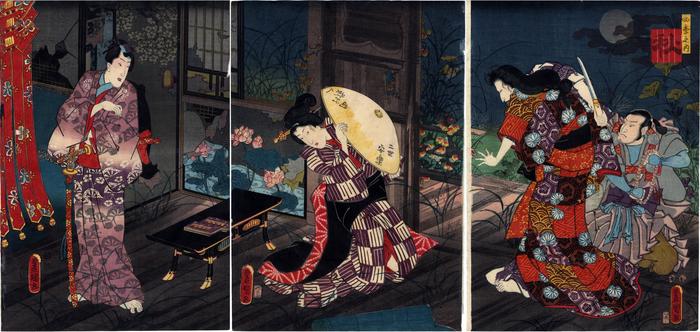Utagawa Kunisada (歌川国貞) / Toyokuni III (三代豊国) (artist 1786 – 01/12/1865)
Autumn (Aki - 秋) from the series The Four Seasons (Shiki no uchi - 四季之内) - a Rustic Genji theme - Kodanji IV as Shinonome on the right, Kikujirō II as Tasogare in the center, and Kumesaburō III as Mitsuuji on the left
1851
30 in x 14 in (Overall dimensions) color woodblock print; ōban triptych
Signed: Toyokuni ga (豊国画)
Publisher: Minatoya Kohei (Marks 332 -seal 24-074)
Censors: Hama and Magome
Museum of Fine Arts, Boston
Lyon Collection - Kuniyoshi triptych on the same theme Bryan Fijalkovich wrote in his master's thesis a summary of this scene:
During the final confrontation with the villainous Shinonome in the ancient temple, Tasogare defends Mitsuuji with the basket hat of “traveling companions”... Once subdued, Shinonome cuts her own throat, but before passing she divulges that her lineage pitted her against Mitsuuji and the Ashikaga shogunate and that she stole the treasure sword in exchange for gold from Ashikaga arch rival, Yamana Sozen. Confronted with loyalty to her mother and love of Mitsuuji, Tasogare also commits suicide. Therefore, instead of the tragic lover’s suicide, Tanehiko inserts the double suicide of mother and daughter. Yet Mitsuuji adds vows of marital tranquility and assurance of his loving companionship to Tasogare in future lives. Mitsuuji stayed true to his motive of finding clues to the lost treasure sword while Tasogare’s suicide kept her honor. However, the two could not overcome their desire for each other. Much like The Love Suicides at Sonezaki, both Mitsuuji and Tasogare uphold the principles of responsibility and human desire.(JSV)
****
This triptych is illustrated in black and white in Sebastian Izzard's Kunisada's World at #84. The text on page 168 reads:
"After a hiatus of nearly five years caused by the death of Ryūtei Tanehiko in the summer of 1842... "Rustic Genji" came back into fashion. Tanehiko's novel had ended abruptly with the publication of chapter 38 in the spring of 1842, despite the publisher's statement on the inside back cover that five new chapters (38 to 42) would be published that year. Senkakudō, the publisher, had been the subject of a two-year government investigation, which resulted int he confiscation of his woodblocks and his bankruptcy in 1844. Rival publishers took up the novel in 1847, however, and two plays featured Mitsuuji (Genji) In 1851. The first, Higashiyama sakura sōshi (The story of cherry blossoms on Hagashiyama), was performed at the Nakamura theater in the eighth month, and the second, Genji moyō furisode hinagata was staged the following month in the Ichimura theater with Ichikawa Danjūrō VIII as Mitsuuji.[The choice of bold type was ours.]
The prohibition against actor prints issued by the shogun's councillor Mizuno Tadakuni in 1842 was still technically in effect, and it was not possible for artists to give the names of either the roles or the actors. The title of this print Autumn, would have signaled to Kunisada's audience that the subject was one of the two autumn productions of 1851. The latter part of 1851 is the only possible date for the triptych, because a new censorship system using date seals in addition to censors' seals was introduced int he second month of the following year.
The scene is probably taken from act 8 of Higashiyama sakura sōshi. The setting is a dilapidated temple where Mitsuuji and his lover, Tasogare, have taken shelter. They are surprised by the sudden appearance of Shinonome, Tasogare's mother, whose family was exterminated by the Ashikaga clan. She confesses to stealing the sword known as Kogarasumaru, the missing Ashikaga heirloom for which Mitsuuji has been searching, and approaches Mitsuuji, intending to murder him.
Ichikawa Kodanji IV (1817-1866) is shown at the right as Shinonome, knife in hand, advancing on Iwai Kumesaburō III (1829-1882), who stands at the left in the role of Mitsuuji. Onoe Kikujirō II (1814-1875) plays the hapless Tasogare in the center, cowering behind her sedge hat. Kunisada's compositon is clearly based on his illustration of the same scene in the fifth chapter of Tanehiko's "Rustic Genji"..."
"Very soon after the publication of this triptych Kunisada's Genji-e imagery became more inventive. He no longer felt the need to recycle his earlier illustrations from "Rustic Genji".In the exquisite erotic book Shō-utsushi aioi Genji of the early 1850s, for example, he shows Mitsuuji making love to Tasogare on the donation box in the ruined temple... At the same time Kunisada lost his monopoly of Genji-e designs; other artists now entered the field."
****
When Kunisada and Tanehiko first collaborated on publishing Rustic Genji ehon Tanehiko stated clearly at the beginning of Chapter 2, in the preface, “I took up the cart of the ‘Aoi’ chapter. A picture book, combining kabuki, puppet plays, and monogatari romance – all three together in one.” Thus he did not hesitate to embrace his sources openly. (JSV)
****
The sasarindō motif which was the family crest of part of the Minamoto/Genji clan appears subtly on the upper part of the Mitsuuji figure on the left.
****
Shinonome, at the least, is a homonym for 'dawn', while Tasogare can mean 'twilight'. The choice of this two related terms to represent the mother and her daughter is interesting.
****
Also listed, but not illustrated, in Genji's World in Japanese Woodblock Prints by Andreas Marks, #G322-03, p. 268.
****
Illustrated:
1) in small black and white reproductions in the Illustrated Catalogues of Tokyo National Museum: Ukiyo-e Prints (3), #2936-38.
2) in a black and white reproduction in Kunisada's World by Sebastian Izzard, Japan Society, Inc., 1993, number 84, page 169.
Genji related prints (Genji-e - 源氏絵) (genre)
Minatoya Kohei (湊屋小兵衛) (publisher)
Ichikawa Kodanji IV (四代目市川小団次: spring 1844 to 5/1866) (actor)
Iwai Kumesaburō III (三代目岩井粂三郎: from 11/1832 to 1/1864) (actor)
Onoe Kikujirō II (二代目尾上菊次郎: 11/1835 to 12/1856 and 1858 to June 1875) (actor)
Ryūtei Tanehiko (柳亭種彦) (author)
